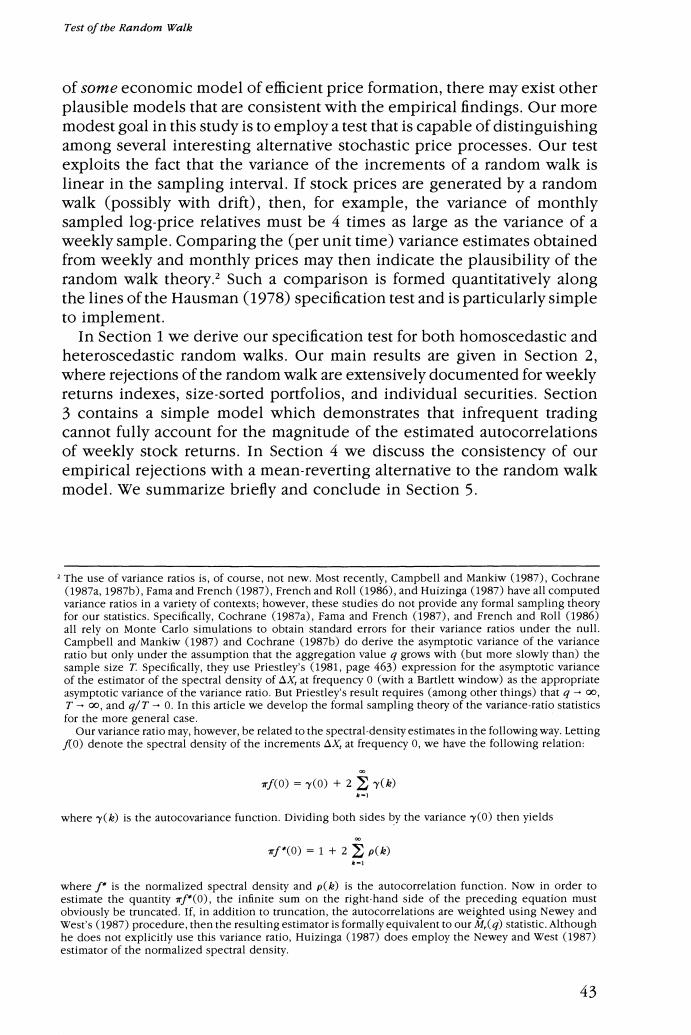正在加载图片...

Test of the Random Walk of some economic model of efficient price formation,there may exist other plausible models that are consistent with the empirical findings.Our more modest goal in this study is to employ a test that is capable of distinguishing among several interesting alternative stochastic price processes.Our test exploits the fact that the variance of the increments of a random walk is linear in the sampling interval.If stock prices are generated by a random walk (possibly with drift),then,for example,the variance of monthly sampled log-price relatives must be 4 times as large as the variance of a weekly sample.Comparing the (per unit time)variance estimates obtained from weekly and monthly prices may then indicate the plausibility of the random walk theory.2 Such a comparison is formed quantitatively along the lines of the Hausman (1978)specification test and is particularly simple to implement. In Section 1 we derive our specification test for both homoscedastic and heteroscedastic random walks.Our main results are given in Section 2, where rejections of the random walk are extensively documented for weekly returns indexes,size-sorted portfolios,and individual securities.Section 3 contains a simple model which demonstrates that infrequent trading cannot fully account for the magnitude of the estimated autocorrelations of weekly stock returns.In Section 4 we discuss the consistency of our empirical rejections with a mean-reverting alternative to the random walk model.We summarize briefly and conclude in Section 5. The use of variance ratios is,of course,not new.Most recently,Campbell and Mankiw (1987),Cochrane (1987a,1987b),Fama and French (1987),French and Roll (1986),and Huizinga (1987)have all computed variance ratios in a variety of contexts;however,these studies do not provide any formal sampling theory for our statistics.Specifically,Cochrane (1987a),Fama and French (1987),and French and Roll (1986) all rely on Monte Carlo simulations to obtain standard errors for their variance ratios under the null Campbell and Mankiw (1987)and Cochrane (1987b)do derive the asymptotic variance of the variance ratio but only under the assumption that the aggregation value g grows with (but more slowly than)the sample size T.Specifically,they use Priestley's (1981,page 463)expression for the asymptotic variance of the estimator of the spectral density of AX,at frequency 0 (with a Bartlett window)as the appropriate asymptotic variance of the variance ratio.But Priestley's result requires (among other things)that g-oo T-oo,and q/T-0.In this article we develop the formal sampling theory of the variance-ratio statistics for the more general case. Our variance ratio may,however,be related to the spectral-density estimates in the following way.Letting f0)denote the spectral density of the increments AX,at frequency 0,we have the following relation: f0)=y(0)+2 where y()is the autocovariance function.Dividing both sides by the variance y(0)then yields f*(0)=1+2 ( h-1 where f is the normalized spectral density and p()is the autocorrelation function.Now in order to estimate the quantity (0),the infinite sum on the right-hand side of the preceding equation must obviously be truncated.If,in addition to truncation,the autocorrelations are weighted using Newey and West's(1987)procedure,then the resulting estimator is formally equivalent to our M,()statistic.Although he does not explicitly use this variance ratio,Huizinga(1987)does employ the Newey and West (1987) estimator of the normalized spectral density. 43